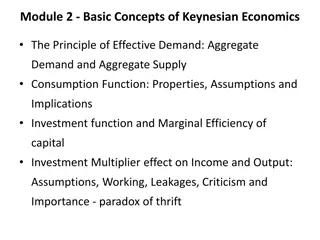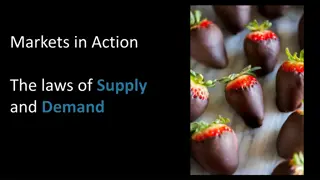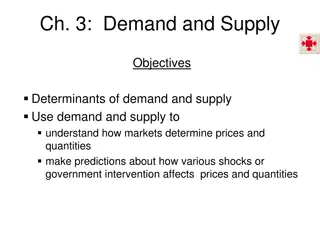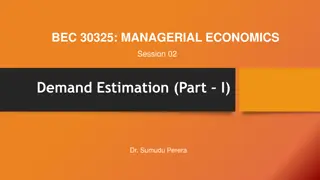Understanding the Law of Demand in Economics
The Law of Demand explains the inverse relationship between the price of a product and the quantity demanded. As the price increases, demand decreases, and vice versa. Factors affecting demand include the price of substitute and complementary goods, consumer income, preferences, and time. The Demand Curve and Elasticity of Demand are key concepts in analyzing consumer behavior and market trends.
Uploaded on Sep 24, 2024 | 0 Views
Download Presentation

Please find below an Image/Link to download the presentation.
The content on the website is provided AS IS for your information and personal use only. It may not be sold, licensed, or shared on other websites without obtaining consent from the author. Download presentation by click this link. If you encounter any issues during the download, it is possible that the publisher has removed the file from their server.
E N D
Presentation Transcript
CHRISTIAN EMINENT COLLEGE, INDORE (Academy of Management, Professional Education and Research) An Autonomous Institution Accredited with A Grade by NAAC E-Content On Law of Demand 03rd June 2020 Prepared By: Prof. Dr. Kiran V panchal Department of Management
Law of Demand Part 1. As PRICE increases, DEMAND decreases Demand goes down Price goes up THEN Part 2. As PRICE decreases, DEMAND increases Price goes down Demand goes up THEN
Law of Demand Law of demand presents the inverse relationship between price of product and quantity of product. When price is high demand of product is less.
Demand schedule A Demand schedule that illustrates the demand for a product at various price level It shows how much consumer desire for a product changes as the price changes
Demand Schedule Price of product (P) 5 10 15 20 25 30 35 40 45 Quantity of product (Q) 55 50 45 40 35 30 25 20 15
Determinants ofDemand Dx is function of (Px,Py,Pz,Y,C,T) Dx= quantity of X product Px = Price of X product Py= Price of Y product that is substitute ( tea or coffee) Pz=Price of z product that is complementary (tea and sugar) Y= Income of consumer C= Choice of consumer T= Time of consumption
Elasticity of Demand The degree to which changes in price cause changes in demand or If we change the price, will demand change a lot or a little?
Price elasticity of demand e(p)= Q/Q P/P Change in quantity with change in price
Elastic Demand If Demand for a good is very sensitive to changes in price, the demand is elastic Or If prices changes a little bit, demand will change a lot!
Example of Elastic Demand Price of Apple goes up even a little bit, demand goes down a lot. Elasticity shows degree of change in quantity with change in price.
Elastic Demand for Apple $16 $15 Price per Pizza $14 $13 Demand for Pizza $12 $11 $10 100 200 300 400 500 600 Number Purchased per Week
Inelastic Demand Demand for a good that consumers will continue to buy despite a price increase is inalstic OR Even if price changes a lot, demand changes very little
Example of Inelastic Demand The price of Salt goes up a lot, the demand stays almost the same. Inelastic demand shows in necessary product
Inelastic Demand for salt $3.50 $3.00 $2.50 $2.00 $1.50 $1.00 $0.50 $0.00 0 10 20 30 40 50 Quantity Demanded (In Thousands)
A Change (Shift) in Demand If other factors changes, the entire demand curve will shift to the left or right The curve does NOT shift if the price of the good is the only change























